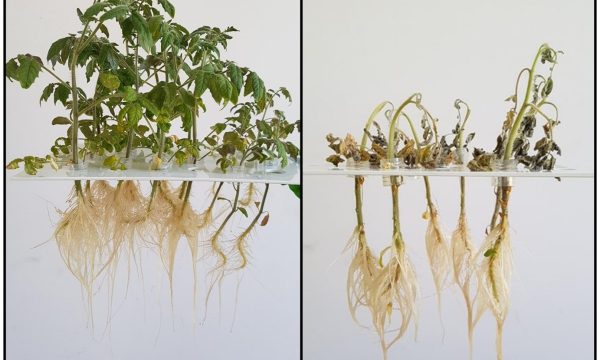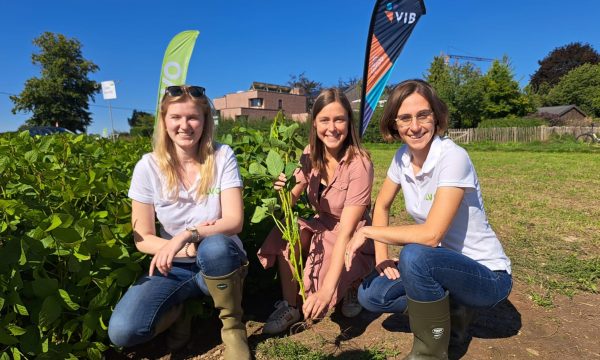Project news Plant Attacker for August: Candidatus Phytoplasma ulmi' (Elm Phytoplasm)

The pathogen: a phytoplasm
The Elm Phytoplasm is a bacterium that cannot be cultivated artificially. It typically grows in the bark vessels or the phloem of trees.
The scientific name for this single cell pathogen is 'Candidatus Phytoplasma ulmi'.
Phytoplasms cause a very wide range of symptoms (discolourations, deformities, phyllodes, rosette formation, witches' brooms, etc.) which can easily be confused with viral diseases or errors in the nutritional balance.
What indicates a phytoplasmic infection in the tree?

The name of the disease clearly refers to the discoloration of the leaves in case of an infestation. The normally dark green foliage typically takes on a greenish-yellow to intense yellow colour. Contrary to yellowing due to nutrient problems, the young leaves do not discolour first.
The disease used to be called elm phloem necrosis. The bacterium grows in the phloem of the tree, causing necrosis and discoloration from below (first in the lower parts) of the tree, which can be determined by removing the bark.
How do the phytoplasmas spread?
The most important way of spreading the elm phytoplasm are vectors of the type of pricking sucking insects. These mainly include cicada-like insects.
The white-striped elm cicada Scaphoideus luteolus is indicated as the main vector, but does not occur in Europe. Also a number of other cicada-like insects and spit bugs (Philaenus spumarius) that are widespread here have since been confirmed as vectors.
Trafficking and thus introduction of infected trees is an important factor in long-distance distribution.
Which plants are susceptible?
The phytoplasm that makes elms sick is extremely elm-specific. North American elm species (Ulmus americana, U. alata, U. serotina and U. rubra) are the most sensitive.
Our smooth (U. minor) and rough elm (U. glabra), are hybrids (U. x hollandica), as well as the flutter elm (U. laevis) are generally more tolerant of the pathogen.
Strongly related phytoplasmas that also belong to the so-called "Elm Yellows" group also affect Carpinus, (hornbeam), Alnus (alder), Vitis (grape) and Rubus (blackberry).
What can you do to prevent a phytoplasmic infestation?
- Select species and breeds that are less susceptible to the disease.
- For elm farms: monitor and control insect populations
- Remove weeds as well as possible.
- Remove infected trees and replace them with other tree species, or at least with less sensitive elm species.
- Ask advice from cultivation supervisors or ILVO
Only 1 observation in Belgium so far

Because this phytoplasm had a quarantine status, the ILVO and CRA-W conducted an extensive survey in elms in various biotopes in Belgium in 2017-2019. This was done as part of GAPHANNEX, a status determination project financed by the FPS VVVL. Sampling was carried out in street trees, parks, forests, along waterways and in private gardens. An intensive survey was also carried out in botanical gardens and arboreta on the elm collections for the Belgian Plant Sentinel Network (BEPSN, financed by the FPS VVVL) as part of a European Euphresco project (the International Plant Sentinel Network). Only 1 elm, an Ulmus minor subsp. canescens, was found in Belgium infected with 'Ca. P. ulmi'. For the time being, therefore, there is only one isolated observation in our region, although there are increasing reports of elms infected with the phytoplasm from neighbouring countries.
De ziekteverwekker – een fytoplasma
Het olmenvergelingsfytoplasma is een niet op kunstmatige voedingsbodems op te kweken bacterie die typisch in de bastvaten of het floëem van bomen gaat groeien.
De wetenschappelijke naam voor deze ééncellige ziekteverwekker is ‘Candidatus Phytoplasma ulmi’.
Fytoplasma’s veroorzaken een heel brede reeks van symptomen (verkleuringen, misvormingen, fyllodie, rosettevorming, heksenbezems, enz.) die gemakkelijk met virusziekten of fouten in de voedingsbalans kunnen verward worden.
Wat wijst op een fytoplasma infectie in de boom?

De naam van de ziekte verwijst duidelijk naar de verkleuring van de bladeren bij een aantasting. Het normaal donkergroene bladerdek gaat typisch vrij algemeen een groengele tot intens gele kleur aannemen. Anders dan bij vergeling door nutriëntenproblemen gaan niet eerst de jonge bladeren verkleuren.
Vroeger heette de ziekte: olmenfloëemnecrose. De bacterie groeit immers in het floëem van de boom, en veroorzaakt er van onder uit (eerst in de lagere gedeelten) van de boom een necrose en verkleuring die kan worden vastgesteld door de bast te verwijderen.
Hoe verspreiden de fytoplasma’s zich?
De belangrijkste manier van verspreiding van het olmenfytoplasma zijn vectoren van het type stekend zuigende insecten. Hiertoe behoren voornamelijk cicade-achtigen.
De witgestreepte olmencicade Scaphoideus luteolus wordt als voornaamste vector aangeduid, maar komt niet voor in Europa. Ook een aantal andere cicade-achtigen en spuugbeestjes (Philaenus spumarius) die hier wel een grote verspreiding kennen, werden intussen als vector bevestigd.
Het verhandelen en op die manier insleep van geïnfecteerde bomen is een belangrijke factor bij lange afstandsverspreiding.
Welke planten zijn vatbaar?
Het fytoplasma dat olmen ziek maakt is uitermate olmenspecifiek. Noord- Amerikaanse olmensoorten (Ulmus americana, U. alata, U. serotina and U. rubra) zijn het meest gevoelig.
Onze gladde (U. minor) en ruwe iep (U. glabra), zijn hybriden (U. x hollandica), alsook de fladderiep (U. laevis) zijn doorgaans toleranter voor de pathogeen.
Sterk verwante fytoplasma’s die ook behoren tot de zgn. “Elm Yellows” groep tasten ook Carpinus, (haagbeuk), Alnus (els), Vitis (druif) en Rubus (braam) aan.
Wat kan u doen om een fytoplasma aantasting te voorkomen?
- Selecteer soorten en rassen die minder gevoelig zijn voor de ziekte.
- Voor opkweekbedrijven olmen: monitor en beheers de insectenpopulaties
- Verwijder onkruiden zo goed mogelijk.
- Verwijder geïnfecteerde bomen en vervang door andere boomsoorten, of minstens door minder gevoelige olmensoorten.
- Vraag advies bij teeltbegeleiders of ILVO
Slechts 1 waarneming in België tot nu toe

Omdat dit fytoplasma een quarantainestatus had, deden het ILVO en CRA-W in 2017-2019 een uitgebreide survey in olmen in diverse biotopen in België. Dit gebeurde in het kader van GAPHANNEX, een door de FOD VVVL gefinancierd statusbepalingsproject. Er werden bemonsteringen uitgevoerd in laanbomen, parken, bossen, langs waterwegen en in privé tuinen. Daarnaast werd ook in botanische tuinen en arboreta een intensieve survey uitgevoerd op de olmencollecties voor het Belgian Plant Sentinel Netwerk (BEPSN, financiering FOD VVVL) kaderend in een Europees Euphresco project (het International Plant Sentinel Network),. Er werd in België slechts 1 olm, een Ulmus minor subsp. canescens, aangetroffen die geïnfecteerd was met ‘Ca. P. ulmi’. Voorlopig is er in onze regio dus slechts een geïsoleerde waarneming, hoewel uit de buurlanden steeds meer meldingen komen van olmen die geïnfecteerd zijn met het fytoplasma.


